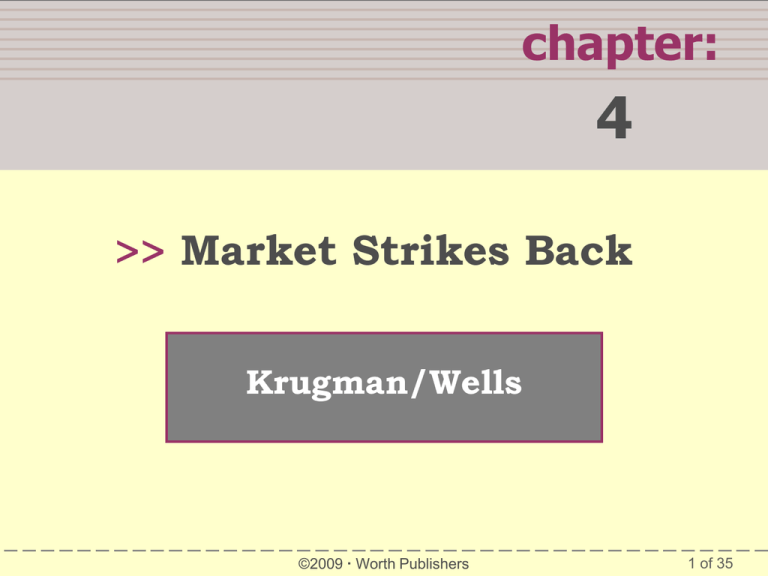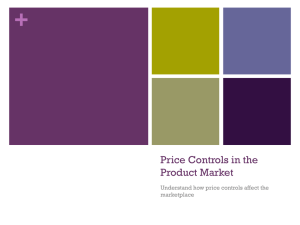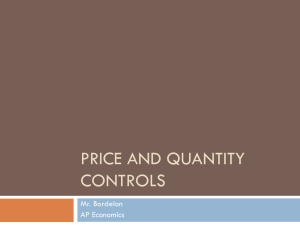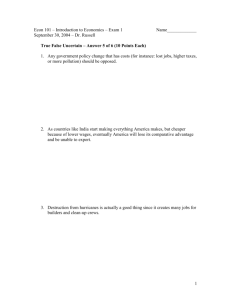Price Controls
advertisement

chapter: SUMMARY 4 >> Market Strikes Back Krugman/Wells ©2009 Worth Publishers 1 of 35 Why Governments Control Prices The market price moves to the level at which the quantity supplied equals the quantity demanded. BUT this equilibrium price does not necessarily please either buyers or sellers. Therefore, the government intervenes to regulate prices by imposing price controls, which are legal restrictions on how high or low a market price may go. Price ceiling is the maximum price sellers are allowed to charge for a good or service. Price floor is the minimum price buyers are required to pay for a good or service. 2 of 35 Price Ceilings Price ceilings are typically imposed during crises— wars, harvest failures, natural disasters—because these events often lead to sudden price increases that hurt many people but produce big gains for a lucky few. Examples: U.S. Government imposed ceilings on aluminum and steel during World War II Rent control in New York 3 of 35 The Market for Apartments in the Absence of Government Controls Monthly rent (per apartment) S $1,400 Monthly rent (per apartment) 1,300 1,200 1,100 E 1,000 900 800 700 600 0 D $1,400 1,300 1,200 1,100 1,000 900 800 700 600 Quantity of apartments (millions) Quantity Quantity demanded supplied 1.6 1.7 1.8 1.9 2.0 2.1 2.2 2.3 2.4 2.4 2.3 2.2 2.1 2.0 1.9 1.8 1.7 1.6 1.6 1.7 1.8 1.9 2.0 2.1 2.2 2.3 2.4 Quantity of apartments (millions) 4 of 35 The Effects of a Price Ceiling Monthly rent (per apartment) S $1,400 1,200 E 1,000 A B Price ceiling 800 Housing shortage of 400,000 apartments caused by price ceiling 600 0 1.6 1.8 2.0 D 2.2 2.4 Quantity of apartments (millions) 5 of 35 How Price Ceilings Cause Inefficiency Inefficiently Low Quantity Deadweight loss is the loss in total surplus that occurs whenever an action or a policy reduces the quantity transacted below the efficient market equilibrium quantity Inefficient Allocation to Customers Wasted Resources Inefficiently Low Quality Black Markets 6 of 35 How Price Ceilings Cause Inefficiency Price ceilings often lead to inefficiency in the form of inefficient allocation to consumers: people who want the good badly and are willing to pay a high price don’t get it, and those who care relatively little about the good and are only willing to pay a low price do get it. Price ceilings typically lead to inefficiency in the form of wasted resources: people expend money, effort and time to cope with the shortages caused by the price ceiling. Price ceilings often lead to inefficiency in that the goods being offered are of inefficiently low quality: sellers offer low-quality goods at a low price even though buyers would prefer a higher quality at a higher price. 7 of 35 How Price Ceilings Cause Inefficiency A black market is a market in which goods or services are bought and sold illegally—either because it is illegal to sell them at all or because the prices charged are legally prohibited by a price ceiling. 8 of 35 Price Floors Sometimes governments intervene to push market prices up instead of down. The minimum wage is a legal floor on the wage rate, which is the market price of labor. Just like price ceilings, price floors are intended to help some people but generate predictable and undesirable side effects. 9 of 35 The Market for Butter in the Absence of Government Controls Quantity of butter (millions of pounds) Price of butter (per pound) Price of butter (per pound) S $1.40 1.30 1.20 1.10 E 1.00 0.90 $1.40 $1.30 $1.20 $1.10 $1.00 $0.90 $0.80 $0.70 $0.60 Quantity demanded 8.0 8.5 9.0 9.5 10.0 10.5 11.0 11.5 12.0 Quantity supplied 14.0 13.0 12.0 11.0 10.0 9.0 8.0 7.0 6.0 0.80 0.70 0.60 D 0 6 7 8 9 10 11 12 13 14 Quantity of butter (millions of pounds) 10 of 35 The Effects of a Price Floor Price of butter (per pound) S $1.40 Butter surplus of 3 million pounds caused by price floor 1.20 A B Price floor E 1.00 0.80 0.60 0 D 6 8 9 10 12 14 Quantity of butter (millions of pounds) 11 of 35 How a Price Floor Causes Inefficiency The persistent surplus that results from a price floor creates missed opportunities—inefficiencies—that resemble those created by the shortage that results from a price ceiling. These include: Deadweight loss from inefficiently low quantity Inefficient allocation of sales among sellers Wasted resources Inefficiently high quality Temptation to break the law by selling below the legal price 12 of 35 How a Price Floor Causes Inefficiency Price floors lead to inefficient allocation of sales among sellers: those who would be willing to sell the good at the lowest price are not always those who actually manage to sell it. Price floors often lead to inefficiency in that goods of inefficiently high quality are offered: sellers offer high-quality goods at a high price, even though buyers would prefer a lower quality at a lower price. 13 of 35 Controlling Quantities A quantity control, or quota, is an upper limit on the quantity of some good that can be bought or sold. The total amount of the good that can be legally transacted is the quota limit. An example is the taxi medallion system in New York. A license gives its owner the right to supply a good. The demand price of a given quantity is the price at which consumers will demand that quantity. The supply price of a given quantity is the price at which producers will supply that quantity. 14 of 35 The Market for Taxi Rides in the Absence of Government Controls Quantity of rides (millions per year) Fare (per ride) Fare (per ride) S $7.00 6.50 6.00 5.50 E 5.00 4.50 4.00 3.50 3.00 0 Quantity demanded Quantity supplied $7.00 6 14 $6.50 7 13 $6.00 8 12 $5.50 9 11 $5.00 10 10 $4.50 11 9 $4.00 12 8 $3.50 13 7 $3.00 14 6 D 6 7 8 9 10 11 12 13 14 Quantity of rides (millions per year) 15 of 35 Effect of a Quota on the Market for Taxi Rides Quantity of rides (millions per year) Fare (per ride) S Deadweight loss $7.00 Fare (per ride) Quantity demanded Quantity supplied $7.00 6 14 $6.50 7 13 $6.00 8 12 $5.50 9 11 5.00 $5.00 10 10 4.50 $4.50 11 9 $4.00 12 8 $3.50 13 7 $3.00 14 6 6.50 6.00 5.50 A The “wedge” E 4.00 B 3.50 3.00 D Quota 0 6 7 8 9 10 11 12 13 14 Quantity of rides (millions per year) 16 of 35








